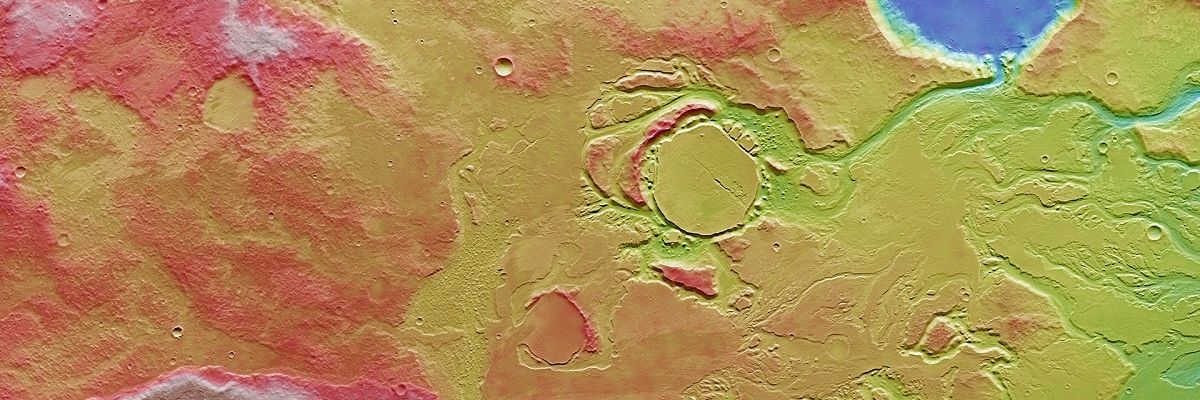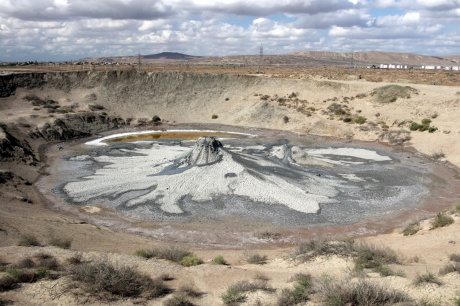
New study reveals that mud may be flowing like lava on Mars
18. 05. 2020
Exploration of Mars has revealed the presence of large outflow channels which have been interpreted as the products of catastrophic flood events during which a large quantity of water was released from the subsurface. The rapid burial of water-rich sediments following such flooding may have promoted an ideal setting to trigger sedimentary volcanism, in which mixtures of rock fragments and water erupt to the surface in the form of mud. The study of the international team led by Petr Brož from the Institute of Geophysics of the Czech Academy of Sciences has been published in Nature Geoscience.
Tens of thousands of conical hills populate the northern lowlands and other places on Mars. The origin of these structures has been widely debated. It has been proposed by many that these cones may represent the surface expressions of such mud eruptions. However, it is difficult to determine whether these edifices are related to mud extrusions or not, partly because the behaviour of extruded mud under martian surface conditions was poorly constrained.
A European team of scientists decided to close this gap in our knowledge. They performed a set of experiments inside a low-pressure chamber during which a water-rich mud was poured over a cold sandy surface. The designed setup for the experiments aimed to partly mimic the hostile martian conditions revealing how the instability of water within the mud changes the mud behaviour. They found that mud exposed to atmospheric pressure as low as that on Mars would propagate in a similar way to some lava flows on Hawaii or Iceland (the so-called pahoehoe flows).
“This is a very exciting and unexpected result. We have a tendency to expect that geological processes, like mud movement, would be operating elsewhere in the Solar system in a similar fashion as on Earth. This is based on our everyday experiences; however, our experiments clearly show that in reality, this simple process which we all know from our childhood would be very different on Mars,” said the research lead author Petr Brož from the Institute of Geophysics of the Czech Academy of Sciences.
The observed phenomena are related to the fact that the martian atmosphere is very thin, actually it is ~150 times weaker than the atmosphere of Earth. And this has significant consequences. Under such surface pressure water is not stable and begins to boil and evaporate. The evaporation removes latent heat from the mud, eventually causing it to freeze.
“This fantastic discovery is another small but important step on a long journey to explore and understand our Solar system. These results remind us that just because we see things on other planets that look like features on Earth, it doesn't always mean they were formed by the same process,” added co-author Ondřej Krýza from the Institute of Geophysics of the Czech Academy of Sciences.

Image showing the crater of Bakhar Satellite mud volcano (Azerbaijan). Conical gryphons with different sizes erupt mud inside the collapsed circular crater. These effusions result in centimeters thick low viscosity mud flows that extend radially from the emission points.
The team showed that the experimental mud flows propagate like terrestrial pahoehoe lava flows, with liquid mud spilling from ruptures in the frozen muddy crust, then refreezing to form a new flow lobe. This finding suggests that mud volcanism can indeed operate on the surface of Mars; however, martian mud volcanoes may be substantially different in shape from terrestrial ones. Therefore putative mud volcanoes on Mars may look very different from their terrestrial equivalent. This work has wider implications, since similar processes may apply to cryovolcanic extrusions on icy bodies in the Solar System.
Prepared by: Petr Brož, Institute of Geophysics of the Czech Academy of Sciences
Photo: ESA and archive of Petr Brož
Read also
- Public Hearing: “Making Sense of Open Science”
- SUNER-C concludes after three years dedicated to the renewable energy future
- A trapped state: The pandemic impact on public attitudes, trust, and behavior
- Aerial archaeology: Tracing the footsteps of our ancestors from the sky
- Archaeologists uncover ancient finds along Prague Ring Road
- Our microbiome largely depends on what we eat, says microbiologist Michal Kraus
- The ABCs of writing: Why did its invention mark a turning point for humankind?
- We learn, remember, forget… What can memory actually do? And can we outsmart it?
- New Center for Electron Microscopy in Brno opens its doors to global science
- The hidden lives of waste: What can we learn from waste workers and pickers?
The Czech Academy of Sciences (the CAS)
The mission of the CAS
The primary mission of the CAS is to conduct research in a broad spectrum of natural, technical and social sciences as well as humanities. This research aims to advance progress of scientific knowledge at the international level, considering, however, the specific needs of the Czech society and the national culture.
President of the CAS
Prof. Eva Zažímalová has started her second term of office in May 2021. She is a respected scientist, and a Professor of Plant Anatomy and Physiology.
She is also a part of GCSA of the EU.